Emmie’s Complex Case Takes Curiosity, Collaboration, and Care
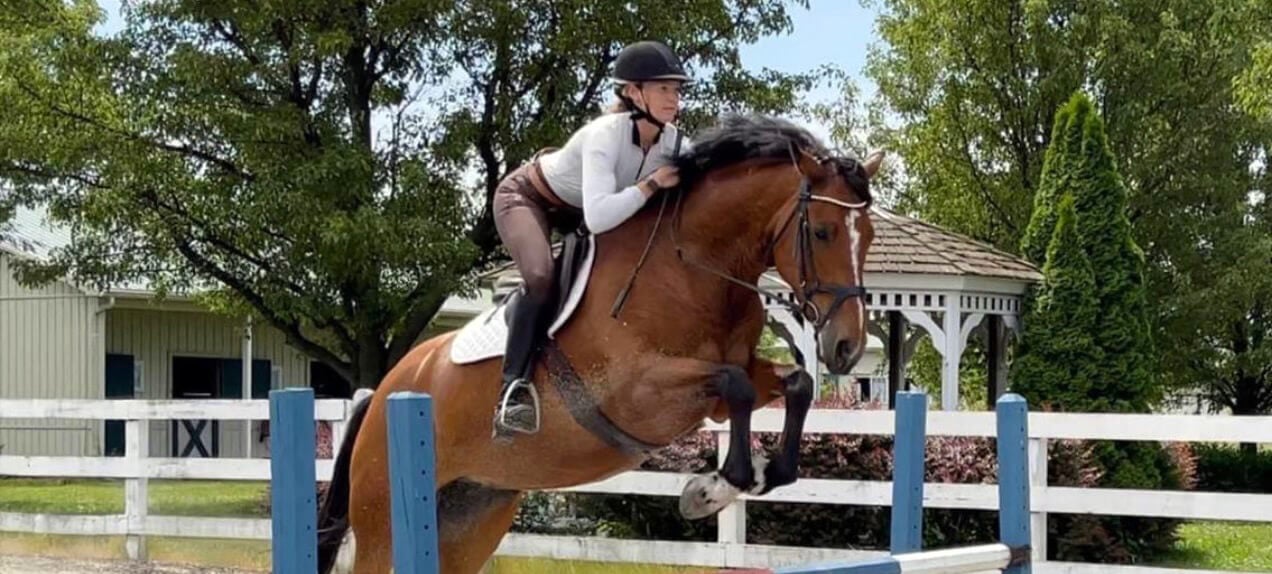
Lauren Schneider welcomed Over the Moon (“Emmie”), an Oldenburg mare, into her life in 2021, marking a return to horses after years spent caregiving for parents and a close friend.
“She was my joyful reentry into a world that I loved, and I was so excited for our future together,” said Schneider.
Emmie was smart and willing, and the two bonded quickly. But in early 2023, something changed. Eight-year-old Emmie began resisting under saddle, first hesitating to move forward, then rearing. Instead of planning their next dressage clinic or show, Schneider took her out of work and started searching for answers.
Initial diagnostics pointed to mild thoracic kissing spines, a condition where spinal bones touch or overlap, causing pain. Emmie received intervertebral steroid injections and Schneider engaged with a certified equine rehab practitioner to develop a core exercise program for Emmie. After only two weeks of gentle exercise, Schneider was disheartened that Emmie had grown more uncomfortable, walking stiffly with a rigid back and shortened stride.
Believing that Emmie’s pained reaction to gentle core work indicated a deeper issue, the rehab practitioner directed Schneider to Penn Vet’s New Bolton Center.
“As luck would have it, I’d just listened to a podcast interview with Kara [Brown, VMD, DACVSMR, assistant professor, Equine Sports Medicine and Rehabilitation] that was a deep dive on kissing spines,” Schneider said. “The way she approached the material—her openness and the ease with which she said ‘we know this but not that’—appealed to me. I fired off an email, and the rest is history!”
A long diagnostic journey
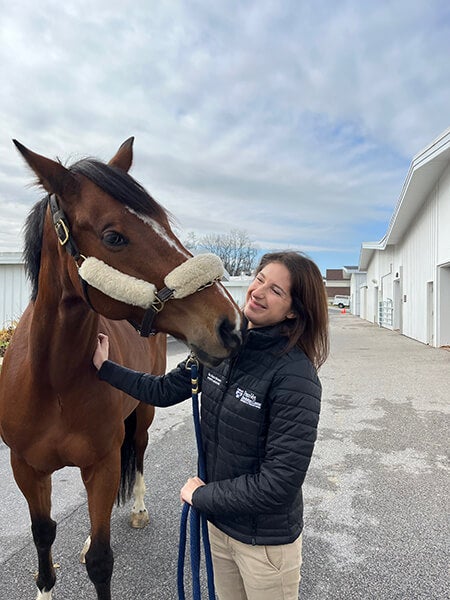
Emmie first arrived at the large animal hospital in July 2023. Her experience would span months and multiple services, including orthopedics, radiology, internal medicine, nutrition, behavior, nursing, and farriery.
The clinical team worked through key diagnostics: Nerve blocks pinpointed the pain to Emmie’s front feet. Advanced imaging—including X-rays, MRI, and PET scans—uncovered other concerns: a fracture in her left front side bone, bone bruising in her right front ankle and coffin or pedal bone, minor strain in the ligaments around her joints, and inflammation in both front coffin joints.
Additionally, a muscle biopsy confirmed myofibrillar myopathy, a disorder that causes muscle pain and weakness. Bloodwork revealed a vitamin E deficiency. And a gastroscopy showed gastric ulcers.
Together, they explained Emmie’s complex pain and performance limitations.
“With performance horses, you’re often dealing with several interconnected issues that influence one another,” said Brown. “Myofibrillar myopathy increases risk for gastric ulcers. Vitamin E deficiencies play a role in muscular health and so forth. It’s a big puzzle, and every piece matters.”
Layered treatments, collaborative care
Emmie’s treatment plan reflected the complexity of her condition and required a layered, individualized approach.
To address the orthopedic issues, she received joint injections, shockwave therapy, and therapeutic glue-on shoes. Rehabilitation, carried out off-site under Brown’s guidance, included daily exercises, core training, and water treadmill sessions. A customized nutrition plan supported muscle recovery and ulcer healing.
Emmie also had a behavioral hurdle to clear. After a stressful trailer experience, she developed severe anxiety around loading. With Schneider, behaviorist Sue McDonnell, MS, PhD, CAAB, HMACT, founder of Penn Vet’s Equine Behavior Program, and Clinical Care Technician Becca Boyle, created a desensitization plan involving aromatherapy, safety cues, and positive reinforcement.
“They worked diligently to help Emmie feel safe trailering again,” said Brown. “This dedication—on weekends, after hours—highlights the commitment of our team. Everyone was empathetic toward everything Emmie was going through and invested in her progress every step of the way.”
A real chance at wellness
It’s taken hundreds of hours of care, and today, Emmie moves with ease and confidence. Her lameness has improved, and she’s returned to structured under-saddle work.
“Emmie’s case was all about collaboration among Emmie’s clinical team and with Lauren,” said Brown. “Her thoughtful, patient, and determined partnership enabled us to tailor care and give Emmie the best chance to heal and thrive.”
The experience has been transformative, said Schneider: “New Bolton Center gave Emmie a real chance to feel well. Without a doubt, this was the most collaborative, methodical, and transparent veterinary process I’ve been through—and I’ve been in the equine world a long time.”
Related News
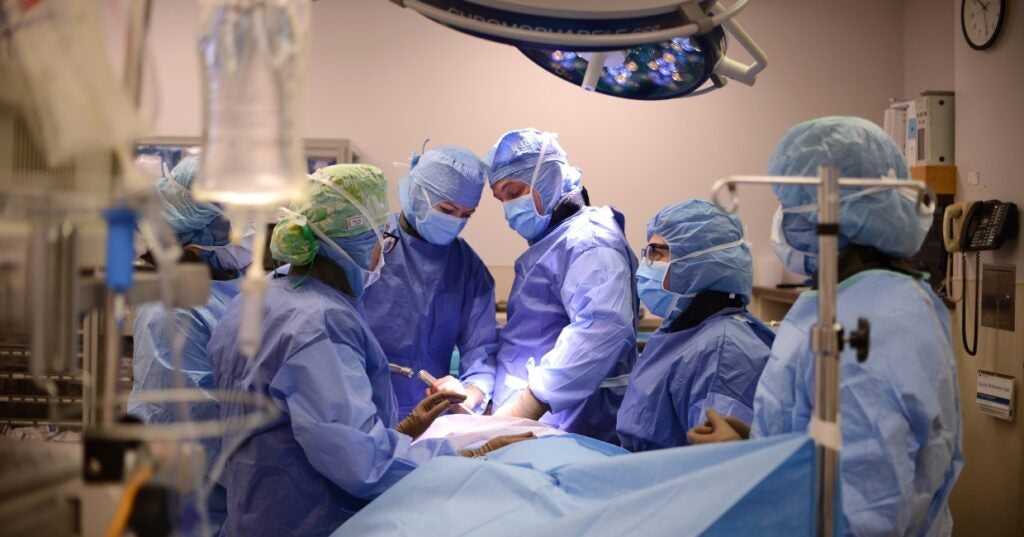
Penn Vet’s Total Hip Replacement Program Helps Heal Dogs With Hip Dysplasia So They Can Live ‘Their Best Lives’
Stephanie and Michael Fullmer fell in love with Cora, a sweet-natured rescue Golden Retriever, as soon as they saw her photo. And Cora loved back – kids, kittens, other dogs,…
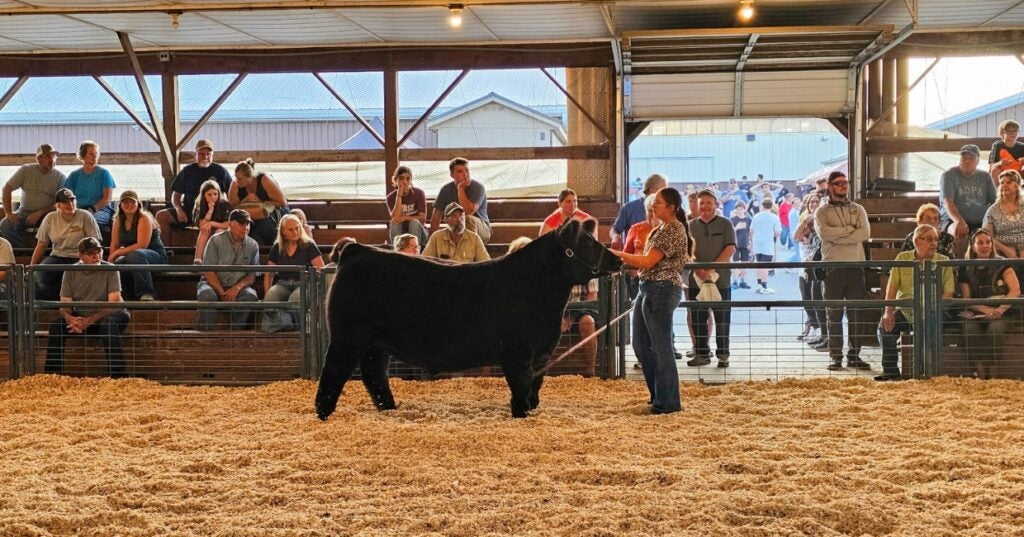
New Bolton Center Surgeons Come Through for Howee the Steer and his Girl
Mallie Touchton was always a farm animal kid. Since she was 8, Mallie was raising and showing her own market livestock – pigs, goats, and dairy calves. Even though she…
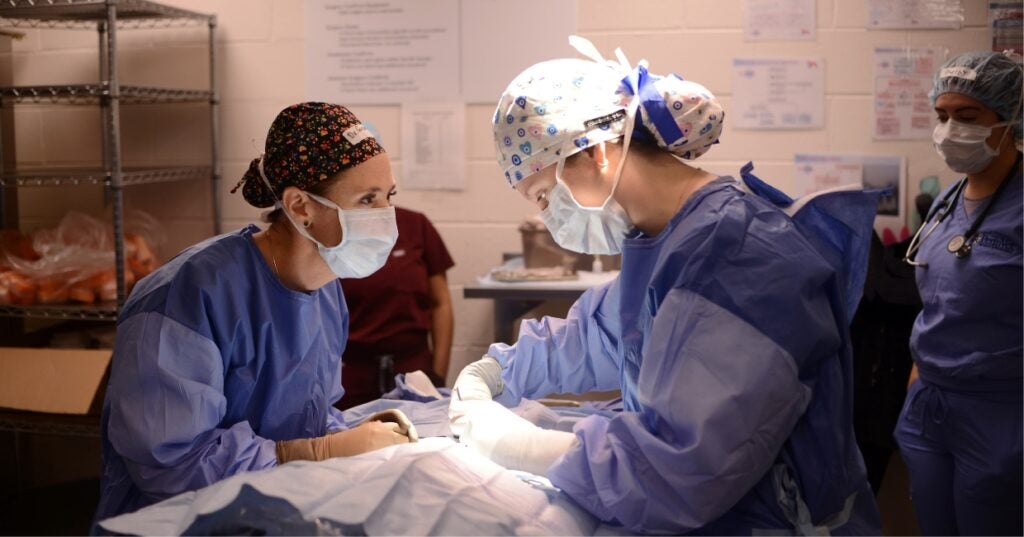
Penn Vet’s Enhanced Approach to Teaching Primary Care Surgery Aims for Career-Ready Graduates
Brooklyn, a white Maltese dressed for warmth in a green frog hoodie, lay in anesthetized slumber under the bright lights of Ryan Hospital’s junior surgery suite. On one side of…
About Penn Vet
Ranked among the top ten veterinary schools worldwide, the University of Pennsylvania School of Veterinary Medicine (Penn Vet) is a global leader in veterinary education, research, and clinical care. Founded in 1884, Penn Vet is the first veterinary school developed in association with a medical school. The school is a proud member of the One Health initiative, linking human, animal, and environmental health.
Penn Vet serves a diverse population of animals at its two campuses, which include extensive diagnostic and research laboratories. Ryan Hospital in Philadelphia provides care for dogs, cats, and other domestic/companion animals, handling more than 30,000 patient visits a year. New Bolton Center, Penn Vet’s large-animal hospital on nearly 700 acres in rural Kennett Square, PA, cares for horses and livestock/farm animals. The hospital handles more than 6,300 patient visits a year, while our Field Services have gone out on more than 5,500 farm service calls, treating some 22,400 patients at local farms. In addition, New Bolton Center’s campus includes a swine center, working dairy, and poultry unit that provide valuable research for the agriculture industry.
